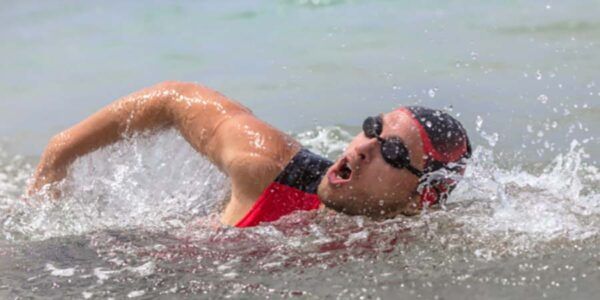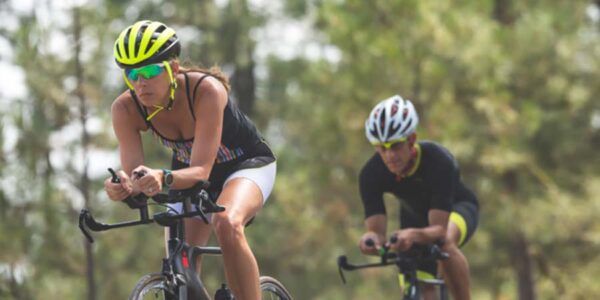What is the triathlon without injury?
A event, although appreciated by many, involves the risk of several injuries. No athlete is immune to injuries. For this reason, this article discusses injuries that are encountered most frequently during this event.
Shoulder tendonitis or shoulder impingement
The suffix “itis” means inflammation. Therefore, we are talking about inflammation of the tendons of the shoulder, which can be accompanied by a pinching during certain movements such as those above the head.
This inflammation is common for swimmers as a result of repetitive movements with the arms above the head. Common symptoms include shoulder pain that may radiate down the arm, pinching sensation, weakness in the arm, difficulty sleeping on the affected arm.

Prevention is the best tool to avoid this type of pain. In order for the tendons to be able to withstand the stress placed on them, it requires optimal shoulder mobility and strength as well as core stability. An evaluation with a physiotherapist may help you analyze your mechanics and determine the shortcomings to be able to work on them and allow you to enjoy your sport without pain.
However, if you begin to feel pain, resting may be helpful by allowing the muscles, tendons, and ligaments to recover. Massaging the shoulder and shoulder blade area may also help the muscles recover following a workout by increasing blood flow to the area and promoting healing. Following an initial period of rest, it is recommended to begin progressively strengthening the shoulder and scapular muscles and to work on the level of mobility. This will prepare you to return to your activity or sport gradually. The key word here is progressive. You could reduce the duration and intensity but increase the number of workouts to allow your body to adapt.
Shin splints and stress factures
Periostitis is an inflammation of the periosteum that covers your bones. This inflammation generally occurs through repetitive compressive stress such as running. It is common occurrence on the medial aspect of the tibia. If the repetitive stress continues to be applied, it can lead to a stress fracture which consists of microfractures.
Common symptoms include pain in the tibia during weight bearing, tenderness on the medial aspect of the tibia and inflammation. Periostitis is often caused by a significant increase in your running volume or your training intensity, which does not give your structures a chance to adapt. Improper running technique can also contribute to increased inflammation.

To prevent this condition, progressive training is essential. An evaluation of your running pattern by a physiotherapist or athletic therapist will allow you to optimize your running while minimizing your risk of injury. In addition, having adequate tools such as a good running shoe will help minimize risk of injury. A healthy diet that includes a calcium and vitamin D will help your bones recover properly.
If you have this condition, a rest period is required which can vary from 4-8 weeks to give your structures a chance to recover. Exercises using a foam roller on the inside and outside fo the calves, mobility exercises and strengthening of the lower limb will help you prepare for your return to running. During the rest period, non-weightbearing exercising and strengthening exercises will benefit you and keep your muscles active.
Iliotibial Band Syndrome
The iliotibial band is a wide, rigid, and thin band that serves as the origin of a muscle of the hip, the tensor fascia lata. This muscle runs along the external part of the thigh and attaches at the level of the knee. When running and cycling, the knee bends and is a repetitive movement. During this movement, the iliotibial band moves back and forth over the outer condyle of the femur. When this structure lacks flexibility, it rubs heavily on the condyle producing inflammation.
Affected individuals may feel pain on the lateral aspect of the knee or thigh during repeated movements at the level of the knee such as cycling, running, and stairs. Inflammation on the lateral aspect of the knee may also be visible.

Several factors can contribute to the appearance of this syndrome.
To avoid this syndrome
- Appropriate running shoes.
- Proper positioning of your bike.
- Optimal running pattern.
- Progressive plan to increase your training volume and intensity.
- Adequate mobility and strength to support you in your training goals.
Physiotherapy can help you
If you feel pain, you may release the iliotibial band using a foam roller. Icing for 15 to 20 minutes a few times a day on the lateral aspect of the knee will help manage the pain and reduce inflammation. This syndrome is can also be the result of a weakness in the hip. Hip strengthening exercises will help address the cause of the pain.
Overuse injuries, such as iliotibial band syndrome, shoulder tendinitis and stress fractures, are common injuries during IRONMAN. Progressive training and beginning to prepare several months in advance will help you minimize your risk of injury. Prevention is priceless and often underestimated. For these reasons, we recommended that all patients do an evaluation with a physiotherapist or an athletic therapist before any major competition in order to have the tools necessary to achieve your goals without pain. If you have persistent pain, take the time to treat it with the help of one of our therapists, because the next competition is never far away!
